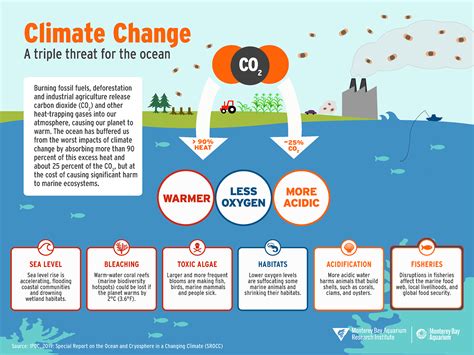Climate change is a pressing issue that continues to impact our planet’s ecosystems in various ways. As the Earth’s climate continues to warm, the delicate balance of ecosystems is being disrupted, leading to significant effects on biodiversity, temperature changes, forest and marine ecosystems, sea levels, desertification, freshwater ecosystems, and species interactions. In this blog post, we will explore the far-reaching impacts of climate change on ecosystems from an environmental science perspective. We will delve into the ways in which climate change affects biodiversity, the role of temperature changes in ecosystem functioning, and the specific impacts on forest, marine, coastal, and desert ecosystems. Additionally, we will examine the effects on freshwater ecosystems and species interactions, and discuss potential mitigation strategies to protect ecosystems from the detrimental effects of climate change. Join us as we unravel the complex relationship between climate change and ecosystems and gain a better understanding of the importance of preserving our planet’s delicate balance.
Table of Contents
Introduction to climate change and ecosystems
Climate change is one of the most pressing issues of our time, and its impacts on ecosystems are becoming increasingly evident. Ecosystems are complex, interconnected networks of plants, animals, and microorganisms, and they provide a wide range of services that are essential for human wellbeing. The functioning of ecosystems relies on a delicate balance of climate factors, such as temperature, precipitation, and carbon dioxide levels. However, as the Earth’s climate continues to warm at an unprecedented rate, these factors are being disrupted, leading to widespread and often unpredictable changes in ecosystems around the world.
The impacts of climate change on ecosystems are far-reaching and multifaceted. From altering the distribution and abundance of species to influencing the productivity and functioning of entire ecosystems, the consequences of climate change are reshaping the natural world in ways that are not yet fully understood. These changes have the potential to have cascading effects on human societies, as they can disrupt essential ecosystem services such as food provision, water purification, and climate regulation.
One of the most concerning aspects of climate change is the acceleration of ecological disruptions that can lead to irreversible changes in ecosystems. For example, the loss of biodiversity due to habitat destruction and species extinctions can have profound and long-lasting effects on ecosystems, as it can destabilize their structure and functioning. Additionally, changes in the frequency and intensity of extreme weather events, such as floods, droughts, and heatwaves, can further exacerbate the vulnerability of ecosystems to climate change.
As we continue to confront the challenges posed by climate change, it is becoming increasingly clear that the preservation and restoration of ecosystems are key components of any effective climate change mitigation and adaptation strategy. By understanding the intricate ways in which ecosystems respond to climate change, we can develop more targeted and sustainable solutions to protect and enhance their resilience. Through collaborative efforts and innovative approaches, we can work towards a more harmonious coexistence with the natural world, ensuring the continued provision of essential ecosystem services for future generations.
How climate change affects biodiversity
Climate change has a significant impact on the biodiversity of our planet. As the Earth’s temperature continues to rise due to the increase in greenhouse gases, the delicate balance of ecosystems is disrupted, leading to loss of habitats and extinction of species.
One of the major ways in which climate change affects biodiversity is through the alteration of habitats. Rising temperatures and changes in precipitation patterns have led to shifts in the geographical ranges of many species, as well as changes in the timing of natural events such as the migration of birds and the flowering of plants. This can lead to habitat loss for many species, as they are unable to adapt to the new conditions.
Another way in which climate change affects biodiversity is through the increase in extreme weather events. Heatwaves, droughts, and intense storms can have devastating effects on ecosystems, leading to the decrease in population of many species and even local extinctions. These extreme weather events can also lead to the destruction of critical habitats, such as coral reefs and mangroves, which are essential for the survival of countless marine species.
Climate change also has the potential to disrupt the delicate balance of ecosystems, leading to the decline of keystone species and the loss of important ecological functions. As temperatures continue to rise, many species are struggling to adapt to the new conditions, leading to a decrease in biodiversity and an increase in the risk of extinction.
The role of temperature changes on ecosystem functioning
Temperature changes play a crucial role in shaping the functioning of ecosystems. As the global climate continues to warm, it is important to understand how these changes impact the interactions and dynamics within ecosystems.
Temperature is a key environmental factor that directly influences the metabolic processes of organisms within ecosystems. Warmer temperatures can accelerate metabolic rates, leading to increased energy consumption and growth in many species. On the other hand, extreme heat can also negatively impact the survival and reproduction of certain species, disrupting the balance within the ecosystem.
Furthermore, temperature changes can also affect the distribution and abundance of species within an ecosystem. As temperatures shift, the geographic ranges of many species may also shift, leading to changes in species composition and biodiversity. This can have cascading effects on the functioning and stability of the ecosystem as a whole.
It’s important to note that temperature changes do not only impact individual species, but also influence the interactions between species. For example, changes in temperature can alter predator-prey relationships, competition for resources, and the timing of key life cycle events such as reproduction and migration. These changes can have significant implications for the structure and dynamics of ecosystems.
Impacts of climate change on forest ecosystems
Climate change has drastic effects on forest ecosystems, leading to shifts in temperature and precipitation patterns which in turn affect the composition and distribution of forests around the world. One of the major impacts of climate change on forest ecosystems is the increased frequency and intensity of wildfires. Rising temperatures and changing precipitation patterns create ideal conditions for the ignition and spread of wildfires, posing a serious threat to the health and resilience of forest ecosystems.
Another significant impact of climate change on forest ecosystems is the disruption of natural cycles, such as insect outbreaks and disease infestations. Warmer temperatures can lead to the proliferation of pests and diseases that can devastate forest populations, leading to widespread deforestation and loss of biodiversity.
Furthermore, climate change can result in the loss of critical habitats for wildlife, as shifting temperature and precipitation patterns alter the geographic ranges of species and disrupt the delicate balance of forest ecosystems. This can lead to a decline in food sources and nesting sites for many species, further exacerbating the challenges faced by forest ecosystems in the wake of climate change.
In addition to these impacts, climate change can also lead to changes in soil composition and nutrient cycling, affecting the ability of forests to regenerate and thrive in the face of environmental challenges. Without effective mitigation strategies and conservation efforts, the impacts of climate change on forest ecosystems will continue to escalate, posing a threat to the vital services and resources that forests provide to the planet.
Ocean acidification: A threat to marine ecosystems
Ocean acidification is a result of increased carbon dioxide levels in the atmosphere, which is largely attributed to human activities such as the burning of fossil fuels and deforestation. The absorption of excess carbon dioxide by the oceans leads to a decrease in pH levels, making the ocean more acidic.
This poses a significant threat to marine ecosystems as many marine organisms, particularly those with calcium carbonate shells such as corals, shellfish, and some species of plankton, are highly sensitive to changes in pH. As the ocean becomes more acidic, these organisms struggle to build and maintain their shells and skeletons, which can have cascading effects throughout the entire food web.
Furthermore, ocean acidification can also impact the behavior, physiology, and reproductive success of various marine species, leading to potential disruptions in population dynamics and the overall functioning of marine ecosystems. Additionally, the acidification of the oceans can also have far-reaching economic impacts, particularly for coastal communities that rely on healthy marine ecosystems for their livelihoods.
It is crucial for us to address the issue of ocean acidification through collective efforts to reduce carbon emissions and mitigate the impacts of climate change. Implementing sustainable practices and policies to limit carbon dioxide emissions and protect vulnerable marine ecosystems is essential in safeguarding the health and resilience of our oceans.
Rising sea levels and coastal ecosystems
One of the most pressing issues facing coastal ecosystems today is the threat of rising sea levels. As a result of climate change, melting polar ice caps and thermal expansion of seawater are causing sea levels to rise at an alarming rate. This has significant implications for coastal ecosystems, as they are at risk of being submerged and eroded by the encroaching waters.
Coastal ecosystems, such as mangrove forests and estuaries, play a crucial role in providing habitat for numerous species and protecting coastlines from erosion. However, with rising sea levels, these ecosystems are under threat of being lost, leading to the potential extinction of many species and increased vulnerability to storm surges and flooding.
In addition to the direct physical impacts of rising sea levels on coastal ecosystems, there are also secondary effects to consider. For example, the intrusion of saltwater into freshwater habitats can lead to the salinization of soils and groundwater, impacting the viability of agriculture and drinking water supplies for communities living in coastal areas.
It is clear that urgent action is needed to address the threat of rising sea levels to coastal ecosystems. This requires not only mitigation efforts to reduce greenhouse gas emissions and slow the rate of sea level rise, but also adaptation strategies to protect and restore coastal ecosystems in the face of inevitable changes.
Climate change and desertification
Climate change is having a significant impact on desertification around the world. The increasing temperatures and changing precipitation patterns are leading to the expansion of arid and semi-arid areas, resulting in the degradation of once fertile land. This process of desertification is exacerbated by human activities such as overgrazing, deforestation, and improper land use, which further accelerates the loss of vegetation and soil erosion.
The effects of desertification are far-reaching, impacting not only the environment but also the livelihoods of millions of people who depend on the land for agriculture and sustenance. As fertile land turns into desert, communities are forced to migrate in search of new areas to support their agricultural needs, leading to social and economic instability.
One of the key challenges in addressing desertification is the need for mitigation strategies to protect vulnerable ecosystems from the impacts of climate change. This involves implementing sustainable land management practices, promoting reforestation and afforestation efforts, and improving soil conservation techniques to restore degraded landscapes and prevent further desertification.
As climate change continues to exacerbate desertification, it is crucial for governments, organizations, and individuals to work together to protect and restore the world’s drylands. By addressing the root causes of desertification and implementing effective adaptation and mitigation measures, we can help safeguard the environment and the livelihoods of those affected by these changes.
Effects of climate change on freshwater ecosystems
Climate change poses a significant threat to freshwater ecosystems around the world. As global temperatures rise, the impacts on freshwater ecosystems are becoming increasingly apparent. One of the most noticeable effects is the alteration of water temperature, which can disrupt the delicate balance of aquatic life.
Another consequence of climate change on freshwater ecosystems is the change in precipitation patterns. This can result in droughts or floods, both of which have detrimental effects on the health of freshwater ecosystems. Droughts can lead to lower water levels and higher concentrations of pollutants, while floods can disturb habitats and wash away important nutrients.
The melting of glaciers and snowpack due to rising temperatures is also a major concern for freshwater ecosystems. This leads to increased water flow in the short term, followed by reduced flow in the long term. In turn, this affects the distribution of freshwater species and can lead to the loss of important habitats.
Lastly, climate change can exacerbate the pollution of freshwater ecosystems through increased stormwater runoff and agricultural runoff. This influx of pollutants can disrupt the natural balance of freshwater ecosystems and lead to the decline of certain species.
The role of climate change in altering species interactions
Climate change has a significant impact on the interactions between different species in ecosystems. As temperatures rise and weather patterns become more extreme, the distribution and abundance of species are affected, leading to changes in species interactions. This can have far-reaching consequences for the stability and functioning of ecosystems.
One of the key ways in which climate change alters species interactions is through changes in predator-prey relationships. As temperatures warm, some species may extend their ranges into new areas, bringing them into contact with new predators or prey. This can disrupt established relationships and lead to shifts in the dynamics of food webs. Predators may also be affected by changes in the availability of their prey, leading to further disruptions in species interactions.
Climate change can also affect the timing of key events in the life cycles of different species, such as migration, breeding, and flowering. As a result, species that rely on each other for pollination, seed dispersal, or other mutually beneficial interactions may become out of sync. For example, if a plant species flowers earlier due to warmer temperatures, the species that rely on its nectar or pollen may not be present, leading to a breakdown in these important interactions.
Furthermore, the impact of climate change on habitat availability can also alter species interactions. As habitats shift or become fragmented, species may be forced to interact with new neighbors, potentially leading to competition for resources or an influx of invasive species. The loss of habitat due to climate change can also drive changes in species interactions, as some species may be forced to coexist in smaller areas, leading to increased competition and changes in community dynamics.
Mitigation strategies to protect ecosystems from climate change
As the impacts of climate change continue to threaten ecosystems around the world, it has become increasingly important to develop and implement mitigation strategies to protect these vital natural habitats. One of the most effective ways to mitigate the impacts of climate change on ecosystems is through the creation and enforcement of protected areas. By designating specific areas as protected, such as national parks or wildlife reserves, we can help to safeguard vulnerable ecosystems from the negative effects of climate change.
Another key strategy for protecting ecosystems from climate change is the restoration and conservation of natural habitats. By actively working to restore degraded ecosystems and conserve healthy ones, we can help to create more resilient environments that are better equipped to withstand the impacts of climate change. This can include efforts to reforest areas that have been cleared for agriculture, as well as the protection of critical habitats for endangered species.
Additionally, it is essential to address the root causes of climate change in order to protect ecosystems. This can involve reducing greenhouse gas emissions through the transition to renewable energy sources, promoting sustainable land and resource management practices, and advocating for policies that support climate resilience and adaptation in ecosystems. By working to mitigate the drivers of climate change, we can help to protect ecosystems from the most severe impacts of a changing climate.
Ultimately, the development and implementation of mitigation strategies to protect ecosystems from climate change is an urgent and critical task. By taking proactive steps to safeguard natural habitats and address the underlying causes of climate change, we can help to ensure the health and resilience of ecosystems for future generations.





